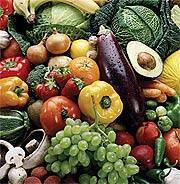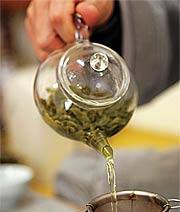Life Extension Magazine®
Lifestyle Changes Alter Gene Expression in Men with Prostate Cancer | |
| Lifestyle improvements have a beneficial effect on gene expression in men with prostate cancer, according to a pilot study published in the Proceedings of the National Academy of Sciences.* Thirty men with low-risk prostate cancer who had opted for active surveillance of their disease in lieu of surgery or radiation treatment participated in the study. For three months, participants consumed a whole food, plant-based, low-fat diet (<10% of daily calories as fat); exercised six days/week; and practiced daily stress management. Diets were supplemented daily with tofu (from soy), soy protein, 3,000 mg fish oil, 200 mcg selenium, 2,000 mg vitamin C, and 100 IU vitamin E. Gene expression in initial prostate biopsies was compared with samples obtained after three months of the lifestyle changes. Forty-eight genes, including those with disease-preventive effects, were found to be up-regulated, and 453 genes, including genes involved in cancer and other diseases, were down-regulated following the intervention. Body mass index, blood pressure, lipids, waist circumference, and mental health also significantly improved. “Intensive nutrition and lifestyle changes may modulate gene expression in the prostate,” the authors concluded. —Dayna Dye | |
| Reference | |
| * Ornish D, Magbanua MJ, Weidner G, et al. Changes in prostate gene expression in men undergoing an intensive nutrition and lifestyle intervention. Proc Natl Acad Sci U S A. 2008 Jun 17;105(24):8369-74. | |
Artichoke Leaf Extract Reduces Cholesterol | |
Artichoke leaf extract reduced cholesterol levels after three months of supplementation in adults.* Extracts of artichoke leaf contain flavonoids, which are known to reduce the risk of cardiovascular disease by preventing the accumulation of fatty deposits in the arteries. Artichoke extracts are used in Europe to improve digestion. In this study, 73 volunteers with relatively high cholesterol but otherwise good health took 1,280 mg of the extract or placebo daily for 12 weeks. At study end, total cholesterol was significantly lower in the supplemented group, with an average decrease of 4% compared with the placebo group, which experienced an average increase of 2%. —Laura J. Ninger, ELS | |
| Reference | |
| * Bundy R, Walker AF, Middleton RW, Wallis C, Simpson HC. Artichoke leaf extract (Cynara scolymus) reduces plasma cholesterol in otherwise healthy hypercholesterolemic adults: a randomized, double blind placebo controlled trial. Phytomedicine. 2008 Apr 16. | |
Milk Thistle May Impede Atherosclerosis | |
| In a recent study, milk thistle fruit extract inhibited the oxidation of low-density lipoprotein (LDL) in a cell-culture assay.* Milk thistle is the source of silymarin complex, often used to treat liver diseases. Oxidation of LDL is an important first step in atherosclerosis. LDL oxidation was induced chemically in cell cultures, and milk thistle extract was added to determine its effect. Milk thistle extract (silymarin) inhibited LDL oxidation by up to 86% compared with no treatment. Further, a specific milk thistle component called silibinin inhibited the adhesion of cells (monocytes) to oxidized LDL. Both effects were dose-dependent, meaning that higher doses offered a greater benefit. If these results are verified in animals and humans, they offer great promise in the treatment of cardiovascular disease. The authors conclude, “it is possible that the extract prepared from the fruits of an easily accessible plant could be useful to prevent the progression of atherosclerotic events.” —Laura J. Ninger, ELS | |
| Reference | |
| * Wallace S, Vaughn K, Stewart BW, et al. Milk thistle extracts inhibit the oxidation of low-density lipoprotein (LDL) and subsequent scavenger receptor-dependent monocyte adhesion. J Agric Food Chem. 2008 Jun 11;56(11):3966-72. | |
Time to Take on Time | |
To significantly reduce disease, we must slow the aging process, according to experts reporting in the British Medical Journal.1,2 “The change in strategy we are calling for requires a systematic attack on aging itself,” they write. “Evidence… suggests that all living things, including humans, possess biochemical mechanisms that influence how quickly we age and that they are adjustable.”1 Due to a greater life expectancy in developed countries, the increased incidence of diseases related to aging has dramatically increased health care costs. If an extended life span is combined with health, it could result in a number of economic, social, and other benefits. Further research is needed to increase knowledge of the aging process and its relationship to disease processes.1 The Alliance for Aging Research has called on Congress to invest three billion dollars annually into research that would increase our understanding of the biology of aging. “To those who ask, ‘Can we afford to invest more in such research?’” Professor Colin Farrelly writes, “We can reply: ‘Can we really afford not to tackle aging?’ The answer clearly is no.”2 —Dayna Dye | |
| Reference | |
| 1. Butler RN, Miller RA, Perry D, et al. New model of health promotion and disease prevention for the 21st century. BMJ. 2008 Jul 8;337:a399. | |
Green Tea Improves Endothelial Function | |
Drinking green tea improves endothelial function in men and women, according to a new study.* Dysfunction of the endothelial cells lining blood vessels is a critical event in the development of atherosclerosis, which can lead to heart attack and stroke. Scientists administered green tea, caffeine, or hot water (placebo) to 14 healthy participants with an average age of 30 years on three separate occasions. Half of the subjects were smokers. Endothelial function was evaluated using flow-mediated dilatation of the brachial artery before the intake of each substance and at 30, 90, and 120 minutes. Caffeine and hot water did not yield significant effects, but there was a 4% peak increase in endothelium-dependent brachial artery dilatation 30 minutes after the subjects consumed green tea. “Green tea consumption has an acute beneficial effect on endothelial function,” the authors concluded. “This may be involved in the beneficial effect of tea on cardiovascular risk.” —Dayna Dye | |
| Reference | |
| * Alexopoulos N, Vlachopoulos C, Aznaouridis K, et al. The acute effect of green tea consumption on endothelial function in healthy individuals. Eur J Cardiovasc Prev Rehabil. 2008 Jun;15(3):300-5. | |
Low Vitamin D Levels Associated with Premature Mortality | |
| Low blood levels of vitamin D are associated with an increased risk of premature death, according to research published in the Archives of Internal Medicine.* An estimated 50% of older individuals in North America do not have satisfactory vitamin D status. Researchers measured more than 3,000 participants’ vitamin D levels and followed them for approximately eight years. Compared with those who had the highest blood levels of vitamin D, those with the lowest levels were much more likely to die from cardiovascular disease and from all causes. Researcher Harald Dobnig, MD, of Medical University of Graz, Austria, told Life Extension that since submitting their study for publication, his group has performed additional analyses on their data. “We were able to demonstrate that low vitamin D status had other significant negative effects in terms of incidence of cancer, stroke, sudden cardiac death, and death of heart failure,” said Dr. Dobnig. Based on their findings, the researchers recommend a serum 25-hydroxyvitamin D level of ≥20 ng/mL (50 nmol/L) for general health maintenance. —Marc Ellman, MD | |
| Reference | |
| * Dobnig H, Pilz S, Scharnagl H, Renner W, et al. Independent association of low serum 25-hydroxyvitamin d and 1,25-dihydroxyvitamin d levels with all-cause and cardiovascular mortality. Arch Intern Med. 2008 Jun 23;168(12):1340-9. | |
DHA Improves Children’s Cognitive Function | |
Docosahexaenoic acid (DHA) supplementation in healthy children improves measures of cognitive function, according to a multicenter US study.* DHA, an omega-3 fatty acid found in the brain, is crucial for development. In this study, 175 healthy four-year-old children were recruited from 11 different sites and randomly assigned to receive DHA 400 mg/day or placebo for four months. Four tests of cognitive function were performed before and after supplementation. At study end, the DHA level in the blood rose 300% in the treated group. Statistical analysis showed a significant association between a higher level of DHA in the blood and better performance on the Peabody Picture Vocabulary Test, which measures listening comprehension and vocabulary. For each increase of 1% in blood DHA, percentile rank on the cognitive test improved by up to nine points. The findings suggest that boosting children’s DHA levels may help promote optimal cognitive function. —Laura J. Ninger, ELS | |
| Reference | |
| * Ryan AS, Nelson EB. Assessing the effect of docosahexaenoic acid on cognitive functions in healthy, preschool children: a randomized, placebo-controlled, double-blind study. Clin Pediatr (Phila). 2008 May;47(4):355-62. |








